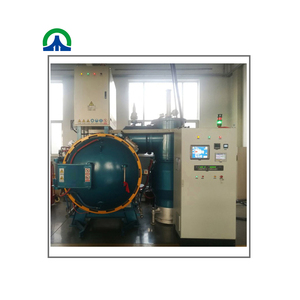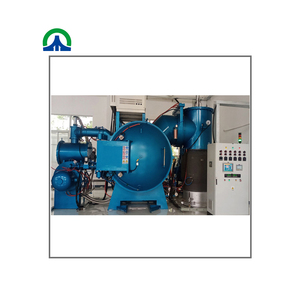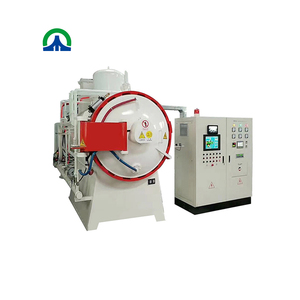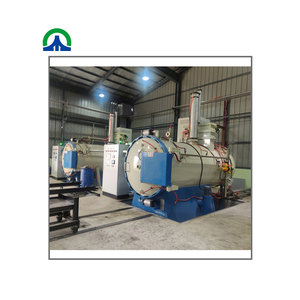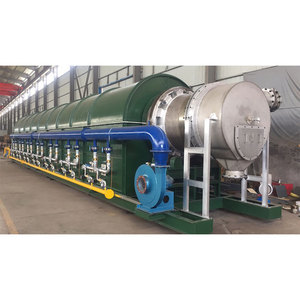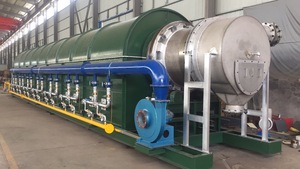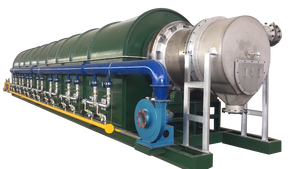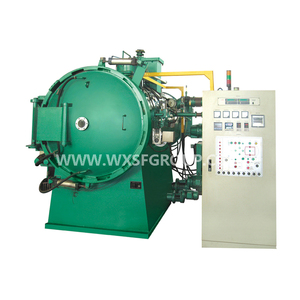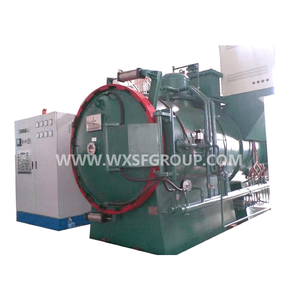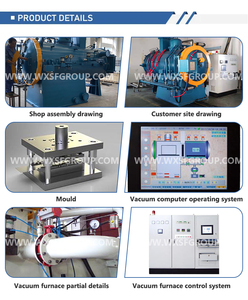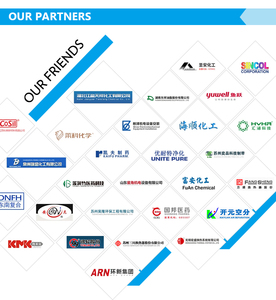Types of calciner furnaces
A calciner is a kind of furnace enabling dry heating or roasting of materials at high temperatures through indirect heating or thermal treatment. The machine is an essential step in the chemical industry to transform materials by changing the physical or chemical properties of the substance.
The calciner furnace is available in different types, including:
- Rotary furnace: The rotary furnace, or calciner rotary kiln, is an industrial furnace that transforms raw materials like limestone into lime. It is the most widely used machine to produce quicklime from limestone through thermal decomposition. Calcination refers to chemically decomposing a substance to form a new product by applying heat. In the rotary calciner for sale, when raw material is fed to the rotary calciner, it moves slowly while being heated by burners along its axis. Other applications of the rotary calciner lie in the production of chemicals and materials like alumina, zirconia, titanium dioxide, sodium sulfate, lithium carbonate, etc. No matter which material is produced, the rotary furnace works promisingly to get the end product of the material through decomposing the material at high temperatures.
- Vertical furnaces: Unlike the vertical shaft furnaces, which allow feed material to move down through the furnace in a counter-current flow, the vertical calciners operate on similar principles to rotary calciners. However, vertical calciners have fixed calciners. Vertical calciners blast hot air upwards and calcine the material. Besides the vertical designs, someovend-style vertical calciners are also widely popular. Vertical calciners are sometimes also called vertical kiln calciners. Furthermore, the vertical furnace does not change its position like the rotary furnace, which makes it easier for manufacturers to produce vertical calciners compared to rotary calciners. The vertical calciner is also considered a cost-effective production solution. Vertical calciners assist in producing materials like magnesia, dolomite, etc.
- Indirect heating calciners: Indirect heating calciners use external heaters to heat the material. Outside heaters supply heat to the material of the furnace through heated walls. This kind of furnace can help businesses avoid any kind of material or product contamination from direct heat in the furnace. Businesses that do not want to have a product contamination issue can choose the indirect heating calciner. Indirect heating calciners are further divided into rotary and vertical types like other kinds of calciners.
Specification and Maintenance
Here are the specifications of a furnace calciner and its maintenance requirements:
-
Applicable Materials
Materials that undergo thermal decomposition or drying in a calciner should be compatible. This means that they won't react negatively with each other or cause any harmful effects. For instance, when lime is heated in a furnace calciner, it turns into quicklime by releasing carbon dioxide from limestone. Therefore, the limestone and calcium oxide mustn't have any adverse interactions during this process, ensuring that the material transforms as intended without unwanted effects.
-
Temprature Regime
Every calciner has its own temperature range based on the material being processed and the desired outcome. For example, the coke calciner temperature may vary between 1100 and 1350 degrees Celsius, while the lime calciner temperature may reach up to 900 degrees Celsius but typically stays around 600 to 800 degrees Celsius. Adjusting a calciner's specific equipment and fuel sources can enable it to reach these higher or lower temperatures if necessary.
-
Heating/Cooling Rates
The heating and cooling rates in a furnace refer to the speed at which temperature increases or decreases during processes. There may be particular requirements regarding how slowly or quickly this happens for various reasons, such as ensuring even heating throughout an entire material or avoiding cracks caused by rapid changes. Some calciner ovens have their heating/cooling rates predetermined, allowing them to control the final heating in a specific area at a certain time.
-
Airflow and Pressure
A calciner's airflow and pressure are crucial for optimising combustion, heat transfer, and material processing. This ensures the correct proportion of oxygen required. Air circulation also helps avoid situations where something burns or explodes inside the machine because there's not enough air pressure. Maintaining proper airflow prevents accidents from happening that could damage equipment or endanger people.
Maintenance requirements:
-
Preventive Maintenance
This approach of keeping equipment running well helps avoid breakdowns and saves money in the long run. It does this by focusing on regular checks and small repairs rather than waiting for things to cost more when they are completely replaced. Equipment is expensive over its entire life cycle. Preventive maintenance for a furnace calciner example includes things like checking seals around doors that could let heat escape or looking at fans moving air through machines to see if they are still working effectively.
-
Repairs
Causes of damage, such as normal wear or overheating, need to be understood so that problems can be fixed correctly the first time. Repairs of a cement Calcinar furnace may touch more complicated parts like motors, combustion systems, and computer controls rather than just small things like door seals and fans that are easier to change on average. This is because cement furnaces work at higher temperatures than others do.
Scenarios
The primary purpose of a calciner is to thermally decompose materials that undergo heat-induced chemical changes. This primary function leads to several key usage scenarios for calciner furnaces in diverse industries.
- Material Decomposition: Calciners are primarily used to facilitate thermal decomposition by applying heat to various materials. The chemical composition of the material usually changes as it gets heated in the calciner.
- Lime Production: Calciners are extensively used in the production of quicklime (calcium oxide) from limestone. When heated to high temperatures in a lime calciner, calcium carbonate decomposes and releases carbon dioxide. This process is known to many as calcination. The end product is quicklime, which has many uses such as metal production, water treatment, soil stabilization, and more.
- Cement Production: Calciner furnaces are key to the production of cement. A major component of cement is limestone. Limestone is heated and calcined in a cement kiln calciner to obtain lime, carbon dioxide, and other materials. Lime and the other products formed from the decomposition of limestone in the calciner are integral parts of cement.
- Soil Stabilization: Lime is a key compound used in improving the quality of soil. After calcining, the lime can be used to chemically alter the soil in order to stabilize it. This will help when construction projects are to take place on the soil. Some soil may be too loose, too swampy, or not strong enough to hold materials like cement, bricks, and wood. Hence, the need to stabilize it by using lime formed from the heating of limestone in the calciner.
- Activated Carbon Production: Calciners play an important role in the production of activated carbon from organic materials like coconut shells, wood, or coal. Organic materials are carbonized in a calciner at high temperatures to remove non-carbon elements such as hydrogen, oxygen, and nitrogen. After this, the carbon derived from the organic material is processed in the calciner at even higher temperatures to produce activated carbon.
How to Choose Calciner Furnaces
Selecting the suitable furnace calciner for specific needs involves various factors, such as performance characteristics, materials and fuel used, emissions, operational flexibility, maintenance, safety, anticipated return on investment and more. Appendix A summarizes some key distinguishing features and specifications of different types of calciner furnaces.
- Performance Characteristics: Assess the calciners' thermal efficiency, tool utilization rates, production capacity, and desired temperature and time for calcination. Choose a suitable calciner based on material properties and goals to balance performance and cost.
- Materials and Fuel Used: Consider available replacement materials and fuel sources, aligning chosen calciner with local resources while minimizing emissions through conversions like coal-to-gas.
- Emissions: Evaluate potential pollutant emissions from material interaction within the furnace system; prioritize selecting appropriate calciners to limit emission levels while maintaining effective processing.
- Operational Flexibility: Consider the desired operational flexibility in terms of the variety of materials that can be processed, the capacity to ramp up or down production as needed, and the adaptability of the calciner's design to accommodate changing business requirements.
- Maintenance: Assess the maintenance requirements, the availability of skilled personnel and service providers familiar with the specific type of calciner, and the likelihood of critical equipment failure or downtime.
- Safety: Evaluate safety risks associated with the calciner's operation, such as high-temperature processes, combustion systems, and potential hazardous material processing, and consider the safety features and protocols implemented in the equipment design.
- Return on Investment: Assess ROI considering factors like initial cost outlaid versus medium-term savings achieved to prioritize selecting efficient equipment while evaluating both upfront investments alongside expected operational cost reductions resulting from chosen technology.
Calciner furnace Q & A
Q: What material are calciners usually made of?
A: Generally, calciners are built from sturdy metal alloys that withstand corrosive materials. Stainless steel is a frequent choice owing to its durability and resistance to high temperatures.
Q: What amount of energy does a calciner consume?
A: Energy requirements vary significantly depending on the material being processed, the design of the calciner, and its operating temperature. However, typical energy consumption might be in the range of hundreds to thousands of megajoules per ton of processed material.
Q: Can a calciner be used for materials other than carbonates?
A: Yes, several calciners are designed for specific materials. For example, rotary kilns can process a wide range of materials, including phosphates, sulfates, and halides, calcining them. However, the suitability of a calciner for a particular material depends on its design, temperature capability, and the chemical nature of the material.
Q: What are the latest technologies in calciner design?
A: Recent developments in calciner technologies include advancements in energy-efficient designs, such as electrification and combined heat and power (CHP) systems, as well as automation and digitization for better process control and monitoring.






























